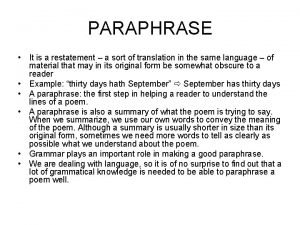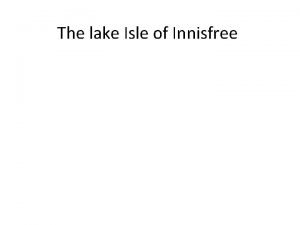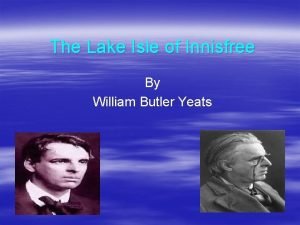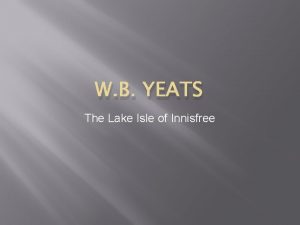The lake Isle of Innisfree Opening comments 3






- Slides: 6

The lake Isle of Innisfree

Opening comments • 3 basic stanzas … 4 lines each • A common poetic theme – the desire to escape the drab misery of the city and live in harmony with nature. • Lots of sound and stunning visuals. • Plenty of effective alliteration and assonance throughout. • From Yeats early period. • Language is easy and accessible. • Regular rhyming scheme – abab, cdcd, efef

1 • Yeats opens with a biblical reference (“I will arise and go now…”) taken from the parable of the prodigal son, suggesting the depth of the speaker’s desire to escape from the city to nature. • He depicts an idealised hermetic existence – He will live alone in a cabin “from clay and wattles made” – He will grow beans and keep honey bees whose humming will fill the glade. – All very nice, romanticised, idealised. • Note the assonance and alliteration throughout emphasising the peace and serenity of the environment

2 • This stanza focuses on the peace the speaker expects to find there. It has a gentle, calm quality…it descends upon the soul like the morning dew settles upon the grass. • The imagery here is particularly beautiful. Peace is described as “dropping slow…from the veils of the morning to where the cricket sings”. • On Innisfree, he tells us, midnight’s all a glimmer, and noon a purple glow, and evening full of the linnet’s wings. – This last line combines sound and visuals. We can both hear and see the linnets in the evening sky. • Again, the stanza is rich in sound effects. Note a combination of long vowel sounds and assonance which emphasise the gentle beauty of the environment.

3 • Yeats returns to his opening line, his statement of deep desire, and adds “for always night and day” he hears the sound of lake water lapping gently in his soul. • Note the completeness of this desire. It’s “always” present…“night and day”. • The sound of the water is of course a metaphor for the ever present desire to escape from the world represented by the “roadway” and “the pavements grey”. Notice, once more, the use of assonance and alliteration for emphasis. • The “deep hearts core” represents the deepest level of his being.

conclusion • The poem uses beautiful, gentle rhythms to generate an almost ethereal or dreamy quality. This fits in nicely with the almost sleepy peace and calm in the 2 nd stanza. Lots of long, broad vowel sounds contribute to this. • Nature in the poem is idealised. This was common in Romantic literature which portrayed nature as an almost heavenly alternative to the modernity of the times. • Although escapist and unrealistic in its material expression the poem expresses the deep longing of the soul for peace and for beauty.







